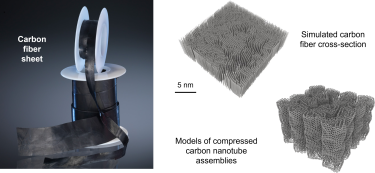
Current and former members of University of Colorado Boulder’s Heinz Research Group have earned prestigious NASA Group Achievement Awards for their research centered on designing lightweight, high-strength materials aimed at reducing the costs of spaceflights.
Crafting such materials is challenging, requiring combining tiny sub-nanometer-sized molecules to meter-sized panels, said Hendrik Heinz, professor of chemical and biological engineering and materials science. His team has been part of the NASA Space Technology Research Institute for Ultrastrong Composites by Computational Design (US-COMP).
“This award recognizes the hard work of my team, including several prolific graduate students, and the amazing efforts and collaborations within the US-COMP team,” he said.
The awards were extended to Heinz and his current and former team members: Amanda Garley (PhD ChemBio ‘22), Krishan Kanhaiya (PhD ChemBio ‘22), Michael Nathanson (MS ChemEng’18) and Jordan Winetrout, a PhD student on the Heinz team.
Heinz emphasized that reducing the weight of required materials through a combination of making them lighter and stronger results in cost savings for both launch expenses and fuel consumption. For example, the cost of launching one pound of spacecraft or cargo to the moon is approximately $10,000 but this cost surges to $1 million for Mars missions, he added.
 Professor Hendrik Heinz
Professor Hendrik Heinz
Consequently, reducing payload weight by just one pound equates to nearly a million dollars in savings for future Mars missions and enhances the transport of essential cargo.
To achieve the goal of creating lightweight, high-strength materials, the team developed cutting-edge simulation methods for analyzing and predicting the thermal and mechanical properties of composite materials, such as carbon fiber yarns and polymer matrix composites.
These simulation methods include the development of the reactive INTERFACE force field (IFF-R), which predicts how those materials soften upon heating as well as how they bend, stretch, and fail. Additionally, the Heinz lab harnessed machine learning techniques to accelerate predictions of materials properties across length scales that surpass the capabilities of traditional computer simulation methods.
